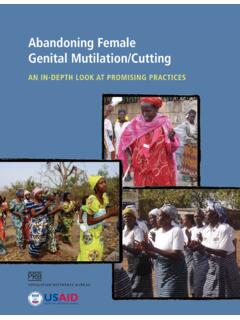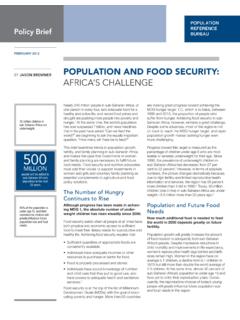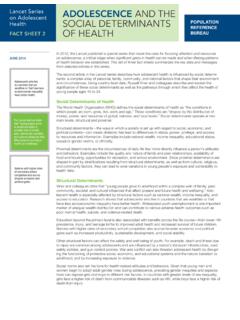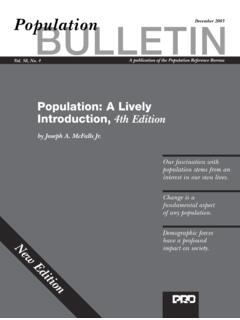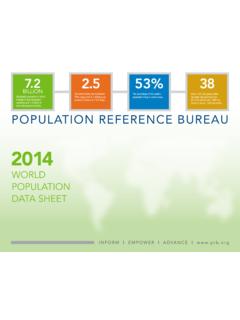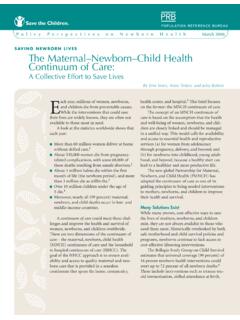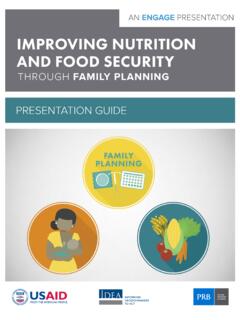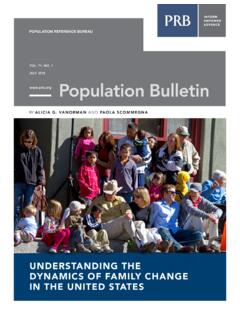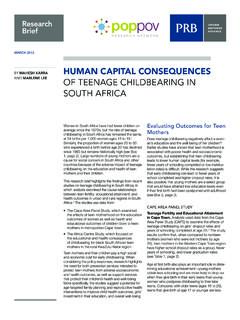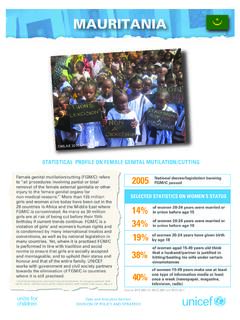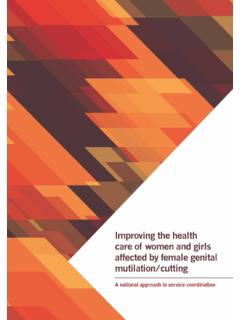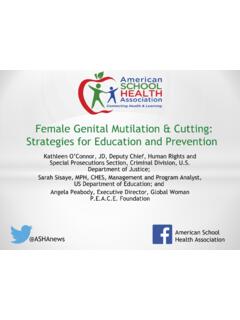Transcription of ENDING FEMALE GENITAL MUTILATION/CUTTING
1 ENDING FEMALE GENITAL mutilation /CUTTINGLESSONS FROM A DECADE OF publication was edited by Charlotte Feldman-Jacobs of the Population Reference Bureau. The desk review and interviews were conducted by consultants Layla Shaaban and Monique Widyono. This publication would not have been possible without the support of Sandra Jordan of USAID, whose dedication to searching for answers has been critical in keeping FEMALE GENITAL MUTILATION/CUTTING on the world s agenda for the last decade. Many thanks also to Sarah Harbison of USAID for her early and sustained commitment to ENDING FEMALE GENITAL MUTILATION/CUTTING , and for her insightful review of this scan of the last decade is dedicated to the memory of Dr. Marjorie Horn, who established the program of support to research and awareness-raising about FEMALE GENITAL MUTILATION/CUTTING at USAID and was tireless in her commitment to eradication of the must also recognize the courageous First Ladies of Africa and all the delegates who met on Feb.
2 6, 2003, in Addis Ababa to declare a day of Zero Tolerance to publication was made possible by the generous support of the American people through the United States Agency for International Development under the terms of the IDEA Project (No. AID-0AA-A-10-00009). The contents are the responsibility of the Population Reference Bureau and do not necessarily reflect the views of USAID or the United States government. Photo courtesy of USAID Safe Schools Project, Malawi. 2013 Population Reference Bureau. All rights 483 1100 PHONE202 328 3937 FAX E-MAIL1875 Connecticut Ave., NW Suite 520 Washington, DC 20009 USAPOPULATION REFERENCE REFERENCE BUREAUThe Population Reference Bureau INFORMS people around the world about population, health, and the environment, and EMPOWERS them to use that information to ADVANCE the well-being of current and future ENDING FEMALE GENITAL mutilation /CUTTING1 ENDING FEMALE GENITAL MUTILATION/CUTTING : LESSONS FROM A DECADE OF PROGRESSPOPULATION REFERENCE BUREAUEXECUTIVE SUMMARY.
3 2 INTRODUCTION ..3 DEFINING FGM/C: WHAT AND WHERE ..5 SUMMARY OF FINDINGS ..6 LESSONS LEARNED ..15 RECOMMENDATIONS ..17 REFERENCES ..19 APPENDICES ..20 ADDITIONAL RESOURCES ..INSIDE BACK COVERTABLE OF CONTENTSENDING FEMALE GENITAL the last 20 years, significant efforts have been made at the community, national, and international levels to address the issue of FEMALE GENITAL MUTILATION/CUTTING (FGM/C). Numerous international and national policy statements have called for an end to FGM/C, which has been recognized as a violation of girls and women s human rights and an obstacle to gender equality. Program planners have implemented countless interventions to educate and empower communities to abandon the practice. Researchers have conducted important studies and evaluations have contributed to a better understanding of the prevalence of the practice and the types of procedures carried out, as well as the reasons communities continue to practice it. Research and experience have begun to lift the veil on the intended and unintended impacts of many of the strategies undertaken over the years.
4 In the first decade of this century progress has been made toward abandonment. Studies have looked at the physical, emotional, and mental impacts of FGM/C. Research has deepened our understanding of the diverse reasons for the continuation of the practice, providing a framework for theories about the origins and social dynamics that lead to its perpetuation. Reflecting the work of dedicated advocates, today most practicing countries have passed laws banning the practice, and prevalence is beginning to decline in some countries. In September 2000, USAID officially incorporated elimination of FGM/C into its development agenda and created the official government policy toward FGM/C. In 2002, the Donors Working Group on FEMALE GENITAL MUTILATION/CUTTING formed to convene key international actors, including representatives of UN agencies, European donors, private funders, and USAID. In February 2003, the Inter-African Committee (IAC) on Traditional Practices Affecting the Health of Women and Children held its landmark conference in Addis Ababa, Ethiopia.
5 Many first ladies of Africa, led by the first lady of Nigeria, officially declared Zero Tolerance to FGM to be commemorated every year on Feb. 6. Drawing from this energy, UNICEF s Innocenti Research Centre organized a consultation in 2004, resulting in a seminal publication, Changing A Harmful Social Convention: FEMALE GENITAL 2008, the Donors Working Group produced A Platform for Action Toward the Abandonment of FGM/C. That same year UNFPA and UNICEF formed a strategic partnership known as the UNFPA-UNICEF Joint Programme on FGM/C s Accelerating Change. They have been working together, in headquarters and field offices, to develop, fund, and implement policies and programs to accelerate abandonment of FGM/C. The results of this program should inform the work of programs and governments for years to 2012, the 67th session of the United Nation s General Assembly passed a wide-reaching resolution urging states to condemn all harmful practices that affect women and girls, in particular FEMALE GENITAL mutilation , giving the work during this decade a powerful boost forward.
6 As stated by Berhane Ras-Work, founding president of the IAC and one of 12 experts on FGM/C who were interviewed for this report, The future is bright. Success has been premised on strengthening conviction, not on using force. Our vision of the way forward has been sharpened by all the work that has been conducted over the years. As we have now passed a dozen anniversaries of Zero Tolerance Day, it is an opportune time to reflect and build on three key maxims that stand strong: First, the centrality of social norms what communities believe and how they act and expect the members of that community to act must be addressed. Second, a wide range of actors play pivotal roles in the abandonment of FGM/C men, women, grandmothers, boys, girls, and community, religious, and political leaders. Third, not every approach will work in every place, every village, every tribe. But if the approach is too narrow and siloed it will not work anywhere. The focus must be on holistic, integrated, multisectoral approaches that bring together the advocacy, policy-level work, and community-level transformation of social norms.
7 In the next decade those seeking the end of FGM/C will have to meet some of the same challenges not addressed in the last decade, including: Wider support from donors, including recipient governments and organizations. Better evaluation of approaches that have been used to date. A closer look at how decisionmaking around FGM/C occurs. Commitments from the wider gender community to embrace FGM/C as an issue needing attention. Responsible health care for women who have been cut. Executive ENDING FEMALE GENITAL mutilation /CUTTING3In the first decade of this century in particular progress has been made toward abandonment. Studies have increased our understanding of the physical, emotional, and mental impacts of FGM/C studies that have helped advocates to advance the case for abandonment. Research has deepened our understanding of the diverse reasons for the continuation of the practice, providing a framework for theories about the origins and social dynamics that lead to its perpetuation.
8 Reflecting the work of dedicated advocates, today most practicing countries have passed laws banning the practice and prevalence is beginning to decline in some countries. Yet all this progress could still be lost if commitments and resources are not continued. Interventions, research, and thoughtful consultations by many NGOs, funders, and bilateral and multilateral agencies have moved the field forward. Several partners USAID, the Department for International Development of the United Kingdom (DFID), the Norwegian Agency for Development Cooperation (NORAD), the World Health Organization (WHO), the United Nations Population Fund (UNFPA), and the United Nations Children s Fund (UNICEF) have been especially visible in this decade, as well as several European and American donors. The IAC, the Gambian Committee on Traditional Practices (GAMCOTRAP), and the Tanzanian Media Women s Association (TAMWA) are a few of the African networks and organizations on the front lines.
9 In September 2000, USAID officially incorporated elimination of FGM/C into its development agenda. In 2001, USAID funded the Population Reference Bureau (PRB) and PATH to produce the report, Abandoning FEMALE GENITAL cutting : Prevalence, Attitudes, and Efforts to End the Practice, which presented an overview of the data on prevalence and practice, as well as interventions showing promise and initial In 2005, the FGM/C Interagency Working Group for USAID commissioned a five-partner report to conduct an in-depth review of interventions around the world addressing FGM/C. The Working Group recognized that a review of evaluated promising approaches to abandonment was needed to move efforts forward. As a result, Abandoning FEMALE GENITAL MUTILATION/CUTTING : An In-depth Look at Promising Practices, was published after a year of analyses of global FGM/C interventions and responses to a questionnaire distributed in 20 countries. The authors identified three promising interventions in three different countries: The Navrongo FGM Experiment in Ghana, The IntraHealth International Five-Dimensional Approach for the Eradication of FGC in Ethiopia, and the Tostan Community Empowerment Program in Senegal.
10 The publication also identified other approaches that warranted follow At the same time, many other donors were actively searching for answers: Where was FGM/C occurring, at what rates, and most important, what lessons could be learned about effective approaches in ENDING the practice? In 2002, Introduction It is my hope that we can see the abolition of [ FEMALE GENITAL MUTILATION/CUTTING ] even sooner than within a generation, but no later than within a generation, and that we also do everything we can to create conditions for every child, girl, and boy, to have the chance to live up to his or potential. Secretary of State Hillary Clinton, Feb. 16, 2012In February 2012, at the first-ever Zero Tolerance Day held at the Department of State, organized by USAID and the State Department, Secretary Clinton spoke passionately about creating conditions for ENDING FEMALE GENITAL MUTILATION/CUTTING (FGM/C) so that every child could realize his or her full potential. Advocates must work in the next decade to achieve this goal, and to learn from the years of work of governments, organizations, and brave individuals and communities.
